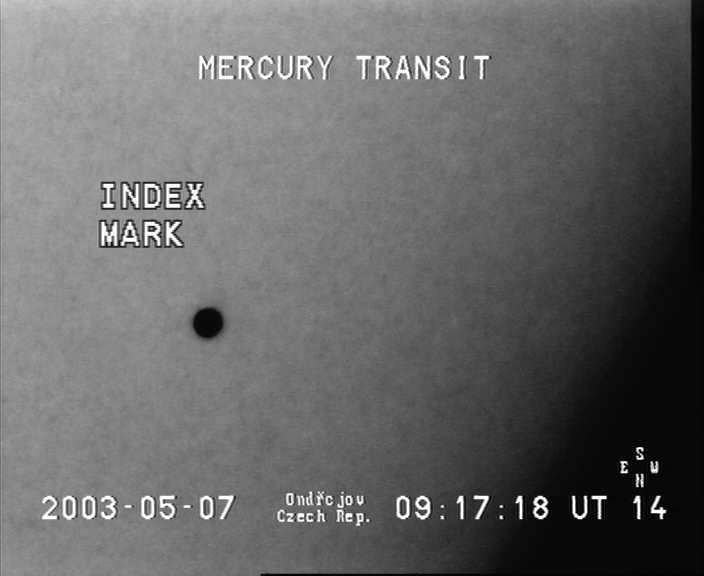

The Venus Transit 2004
... Brief InfoSheet A2
The Mercury Transit
On May 7, 2003, the planet Mercury passed in front of the Sun as a small dark point. This event was well visible from Europe, Africa and Asia, and most observers were lucky enough to have very nice weather in order to enjoy the show. The disc of Mercury is however very small and was therefore very difficult to see. A powerful telescope was needed to observe this event and to show clearly how Mercury moves across the solar disc.
But it was a fine "prelude" to the even more fascinating and important celestial event of this year on June 8, 2004, when the larger planet Venus will pass in front of the Sun.
| Mercury is the planet closest to the Sun, the innermost of all worlds in the solar system. It revolves around the Sun in an elliptical orbit at a mean distance of 58 million km. Mercury's orbit is very eccentric. When at "perihelion" (the orbital point where a planet is closest to the Sun), Mercury is about 46.0 million km from the Sun and at "aphelion" (the orbital point farthest from the Sun), it is at a distance of 69.8 million km. It is therefore about 1.5 times more distant in aphelion than at perihelion - this is also expressed by the orbital "eccentricity" which is rather large (0.2056). For comparison, the eccentricity of the Earth's much more circular orbit is only 0.0167. | |
Mercury, as the innermost planet, is also the fastest moving major planet in the solar system. The mean orbital velocity is about 48 km/s (the Earth moves at 30 km/s). Mercury's sidereal period is about 88 Earth days - this is the interval of time one body needs to complete one revolution around another body with reference to the stars. The synodic period of Mercury is about 116 Earth days - this is the interval of time until Mercury again is in the same position relative to the Sun, as seen from the Earth (the difference is caused by the simultaneous motion of the Earth in its orbit). Both periods are the shortest of any major planet.
On the average, there are 13 Mercury transits each century, i.e. about one every 7 1/2 years. However, they do not occur at regular intervals, but in succession at intervals of 13, 7, 10 and 3 years. Each year, the Earth passes Mercury's line of nodes around May 7 and November 9. Mercury transits can therefore only happen around these dates. Last year, the transit took place on May 7, 2003, and the next events occur on November 8, 2006 and May 9, 2016.
More information
This topic is discussed in a more detailed way on the Mercury Transit 2003 pages. Short notes are also available directly from the students and teachers pages. Pictures of the 2003 events taken with different telescopes are available on the Mercury Transit Central Display and Webcam pages.

